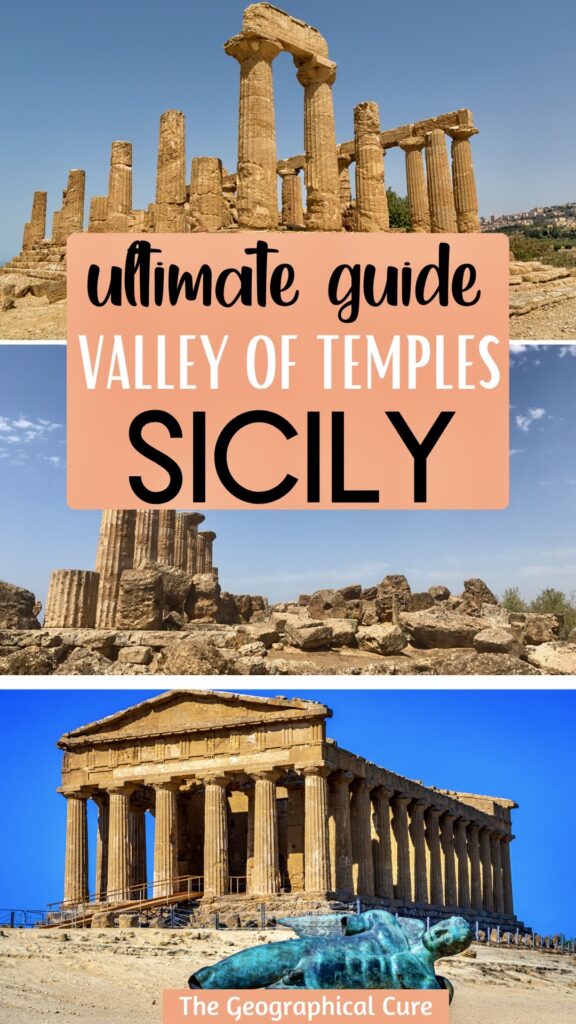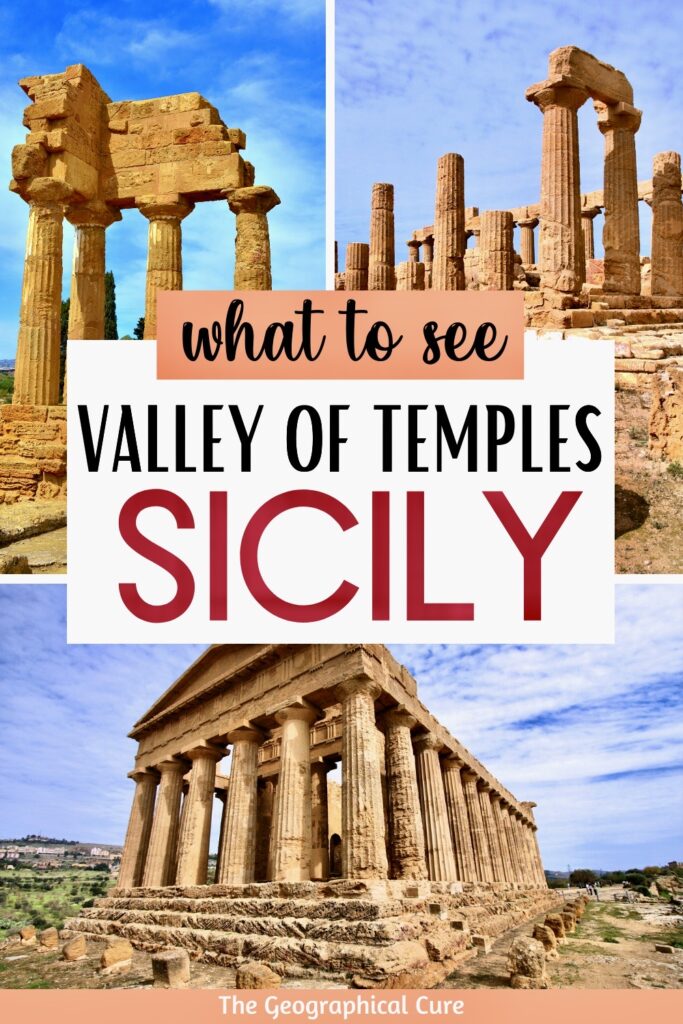Here’s my guide to visiting the majestic Valley of the Temples in Agrigento Sicily, with must know tips for visiting.
The Valley of the Temples is the world’s largest archaeological site and Sicily’s star attraction. Lying on the island’s southern coast, the complex is chock full of spectacular Greek ruins.
In 1997, the Valley of the Temples became a designated UNESCO site. It’s an ancient wonder that has attracted travelers throughout history. Indeed, some say the best preserved Greek ruins are found, not in Greece, but in Sicily.
The temples were once shiny and new, showcasing the power of the Greek culture and ancient Agrigento. Today, some lie in romantic ruins among olive groves while others are in pristine condition.
Pure in line and logic, these honey-colored Doric temples boast a stunning setting in a rolling valley ridge. The lyric poet Pindar called this part of Sicily “the most beautiful city of mortals” and Cicero claimed the valley “does not know a sunless day.”
You can’t help but be transported back to the 6th century B.C. You can scamper over their steps, sit amid the ruins, and gaze out onto the sea.
History Of The Valley Of The Temples
The town of Agrigento was founded by Greeks in 580 B.C. and named Akragas. The region was reputedly home to the goddess Persephone, whose job was to protect Akragas.
At the time, it was a wealthy city of almost 200,000 people. Akragas lasted until the Carthiginians conquered the city in 406 B.C.
The valley once held 15 temples built by Carthaginian slaves. Each temple was dedicated to a god performing different tasks. The temples were made of sandstone, which was then covered with white plaster to help prevent erosion.
The Greeks chose Akragas for its great rolling plains and dramatic heights, which contrasted with the craggy narrow valleys of Greece.
The dramatic temples weren’t intended for public use. The ordinary citizen could only observe them from afar.
How were the temples built? From a technical point of view, they were planned in advance with the architect providing precise drawings and measurements.
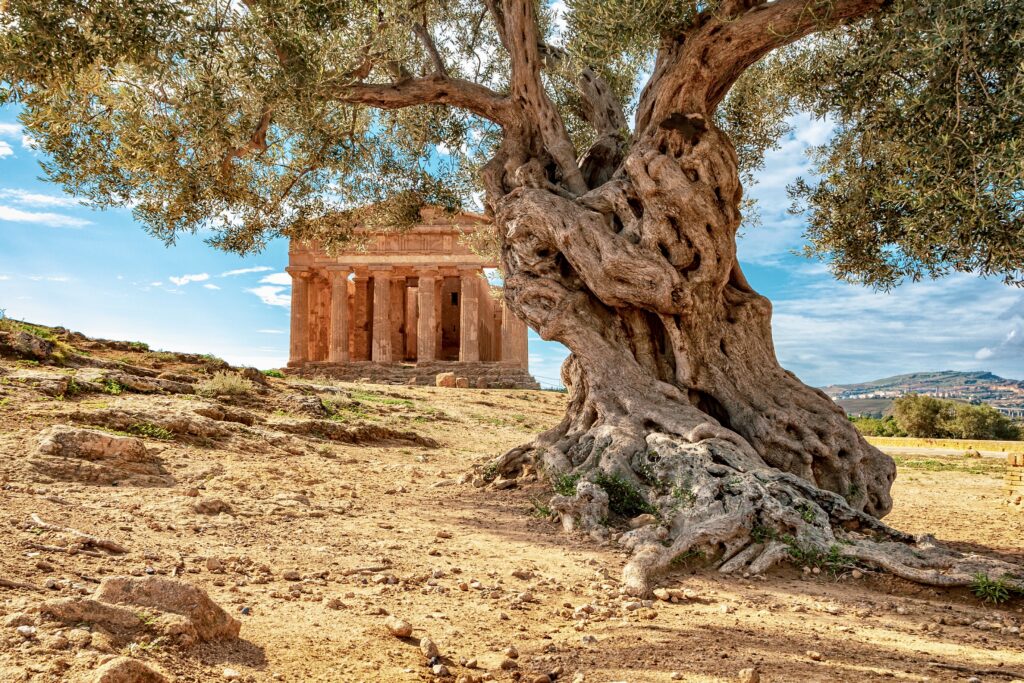
The temples were built with sandstone from a nearby quarry. Each stone was cut to a specific dimension. They were rolled on a ramp over logs to the construction site. The stone slabs were then raised and put in place using cranes and pulley systems powered by slaves.
The columns were built with drums, held in place by pegs. Once stacked up, they were “fluted” with vertical grooves. The entire temple was then coated with plaster and painted in vivid colors.
Archaeologist Domenico Antonio Lo Faso Piestrasanta discovered and unearthed the temples in the 19th century. Today, the archaeological complex includes the ruins of seven ancient Greek temples.
Excavations continue to this day. The city, or polis, is mostly still buried and only now being unearthed. The most recent find is a small theater near the museum.
In August 2023, archaeologists also discovered a huge cache of votive objects near the Temple of Juno. Those are offerings made to deity or other revered figure as an expression of devotion or supplication.
The find consisted of 60 terracotta statuettes, busts, and fragments of bronze. They may have been placed there after the Carthaginians pillaged the city.
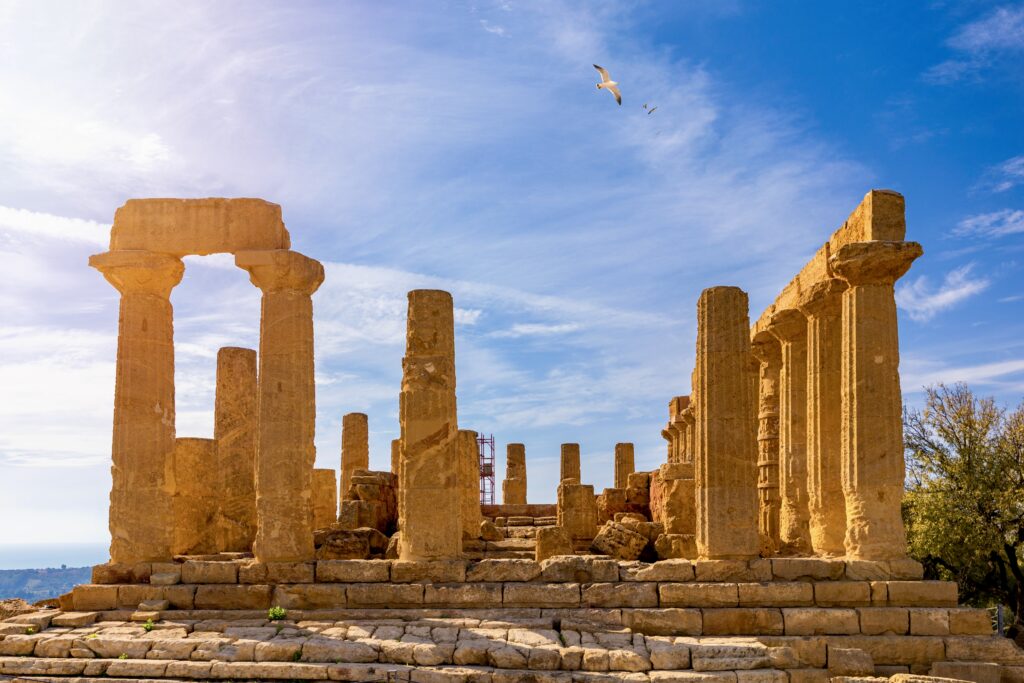
Tickets & Tours For The Valley Of The Temples
In high season, you should pre-book a skip the line ticket to avoid lines. I also advise booking a guided tour because, apart from the Archaeological Museum, there’s not much informational signage at the site itself.
You can book a guided tour from Catania or a guided tour from Palermo. You can also book a longer full day tour from Catania or from Palermo that includes a visit to the nearby Villa Romana del Casale.
I thought the villa was one of the most spectacular ancient sites I saw in Sicily. So, if you don’t mind a long day, this is an excellent option.
It will be a long haul, but you can also visit the temples on a tour from Taormina.
If you are driving or taking public transport to Agrigento, you can also book a 2 hour guided tour that meets at the Via Panoramica Valle dei Templi in the valley. Or a 3 hour private tour with an expert local guide.
Guide To The Valley Of The Temples: What To See
Here are the main sites to see when visiting the Valley of the Temples.
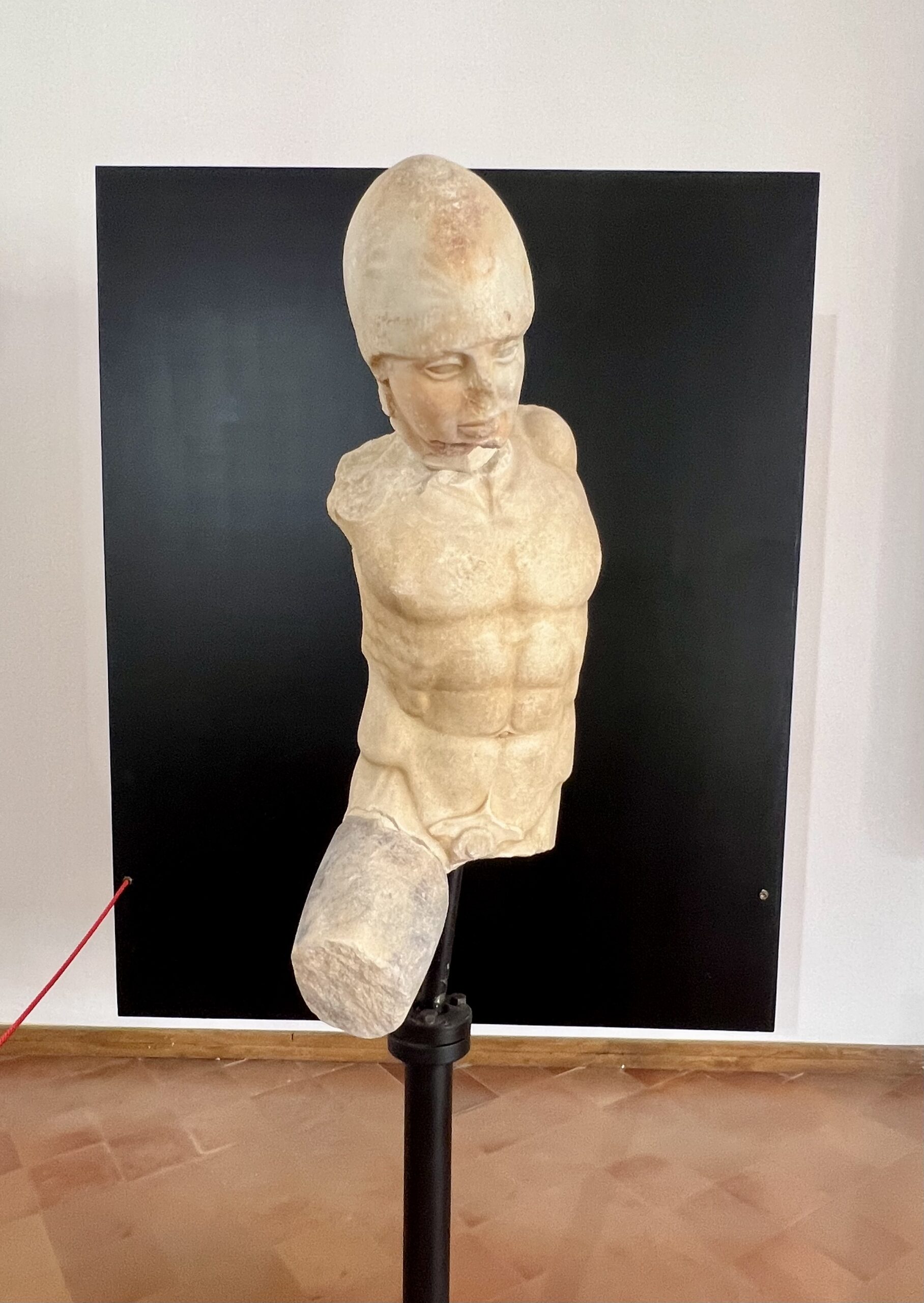
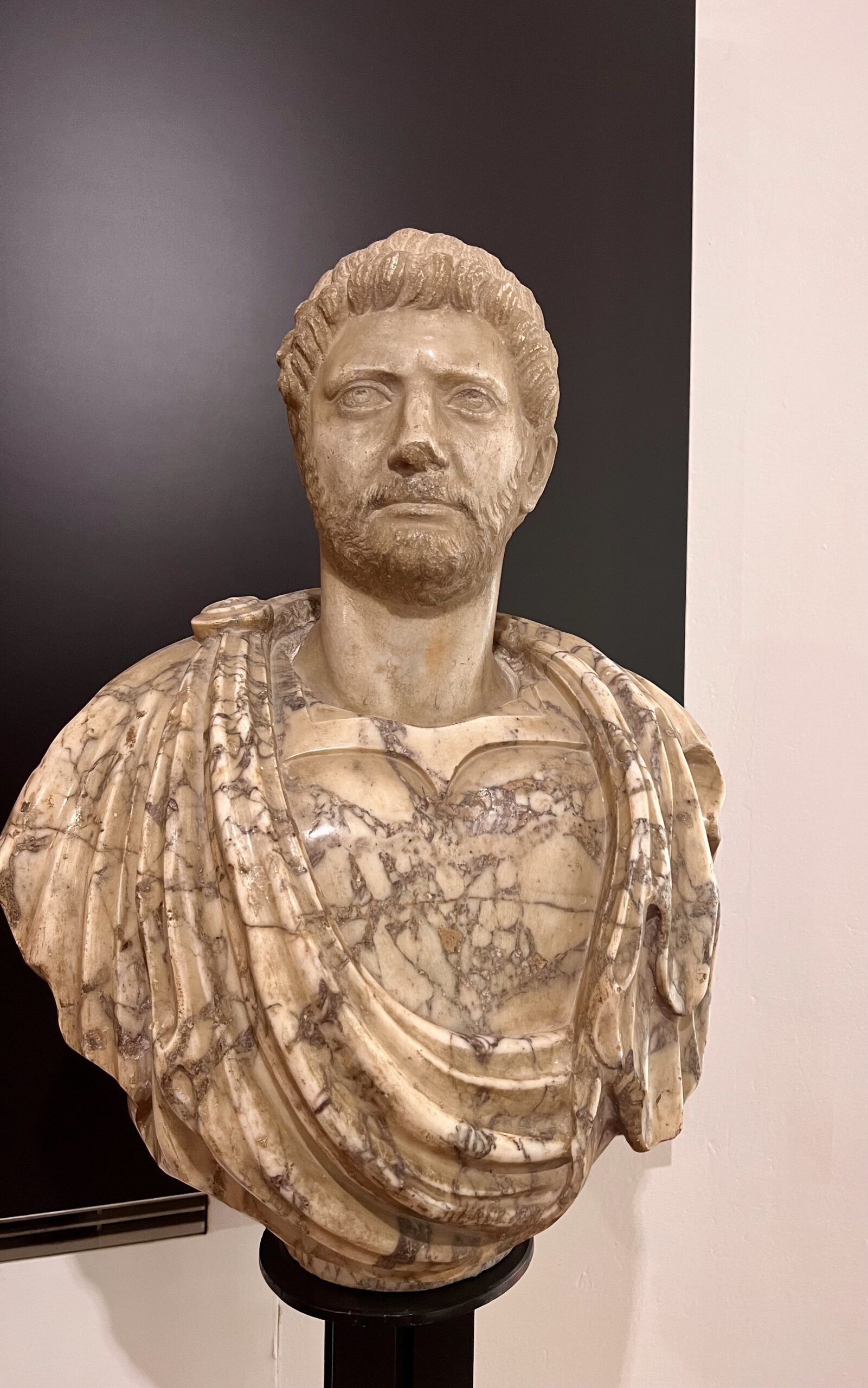
1. Pietro Griffo Regional Archaeological Museum
It’s best to start your visit to the Valley of the Temples at the extremely well-curated Archaeological Museum. It’s one of Europe’s best archaeological museums and set within a 14th century Cistercian monastery.
The museum provides a good introduction to the valley, with a brilliant collection of artifacts recovered from excavations in the area. The exhibits span over 2,000 years and are presented in 18 rooms.
The key highlights include relics from the prehistoric age, Mycenaean age, ancient Greece, and ancient Rome. The exhibits are labeled in Italian and English (until the last rooms). It’s hard to take photos because the museum is dimly lit and everything is displayed in glass cases with small spotlights installed inside.
Among the highlights are a stunning collection of well-preserved Greek vases from the 7th century B.C., urns, statues, kraters, mosaics, coins, weapons, and paintings. The Greek vases are rendered in both the “black figure” and (more sophisticated) “red figure” techniques.
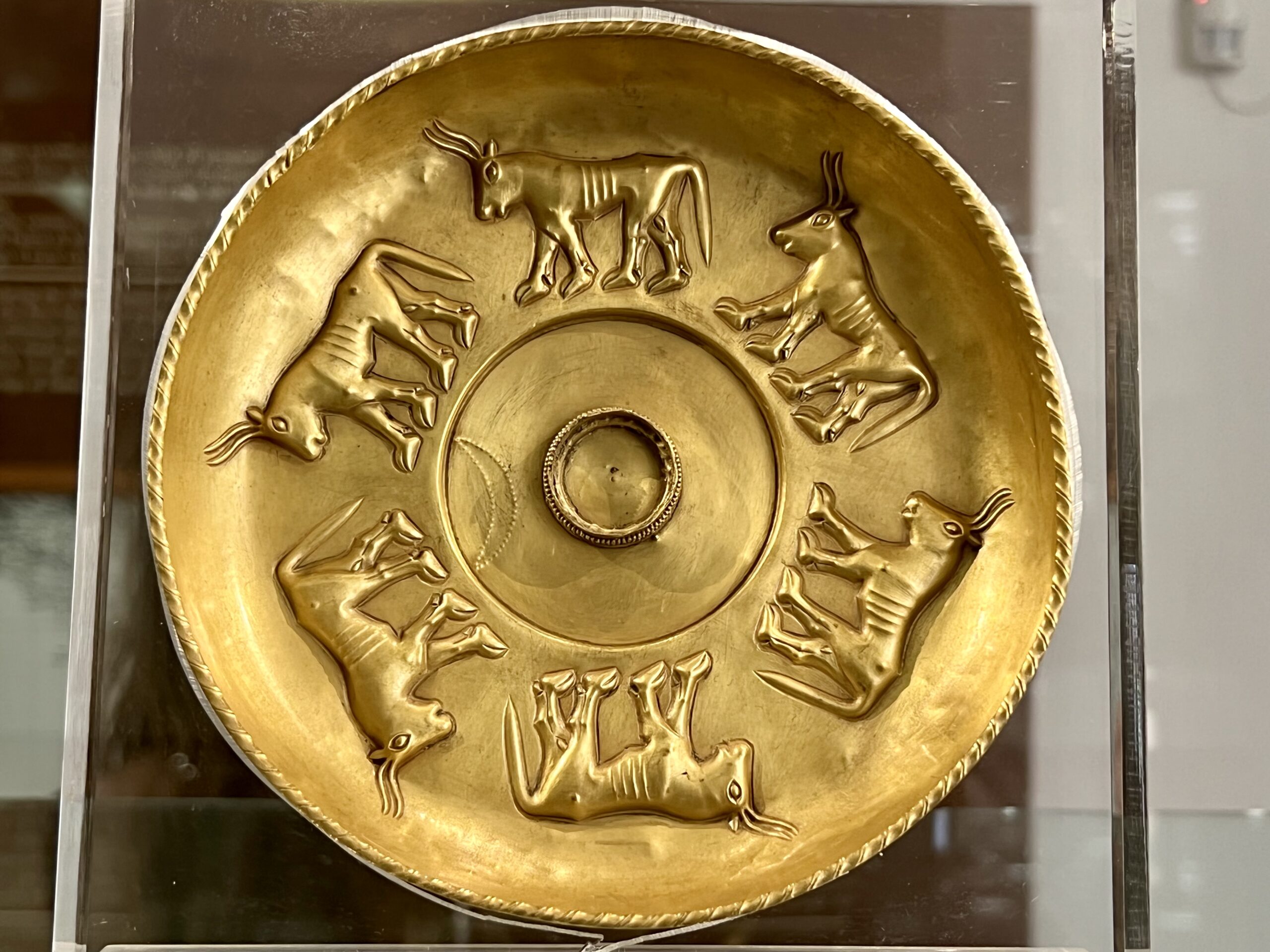
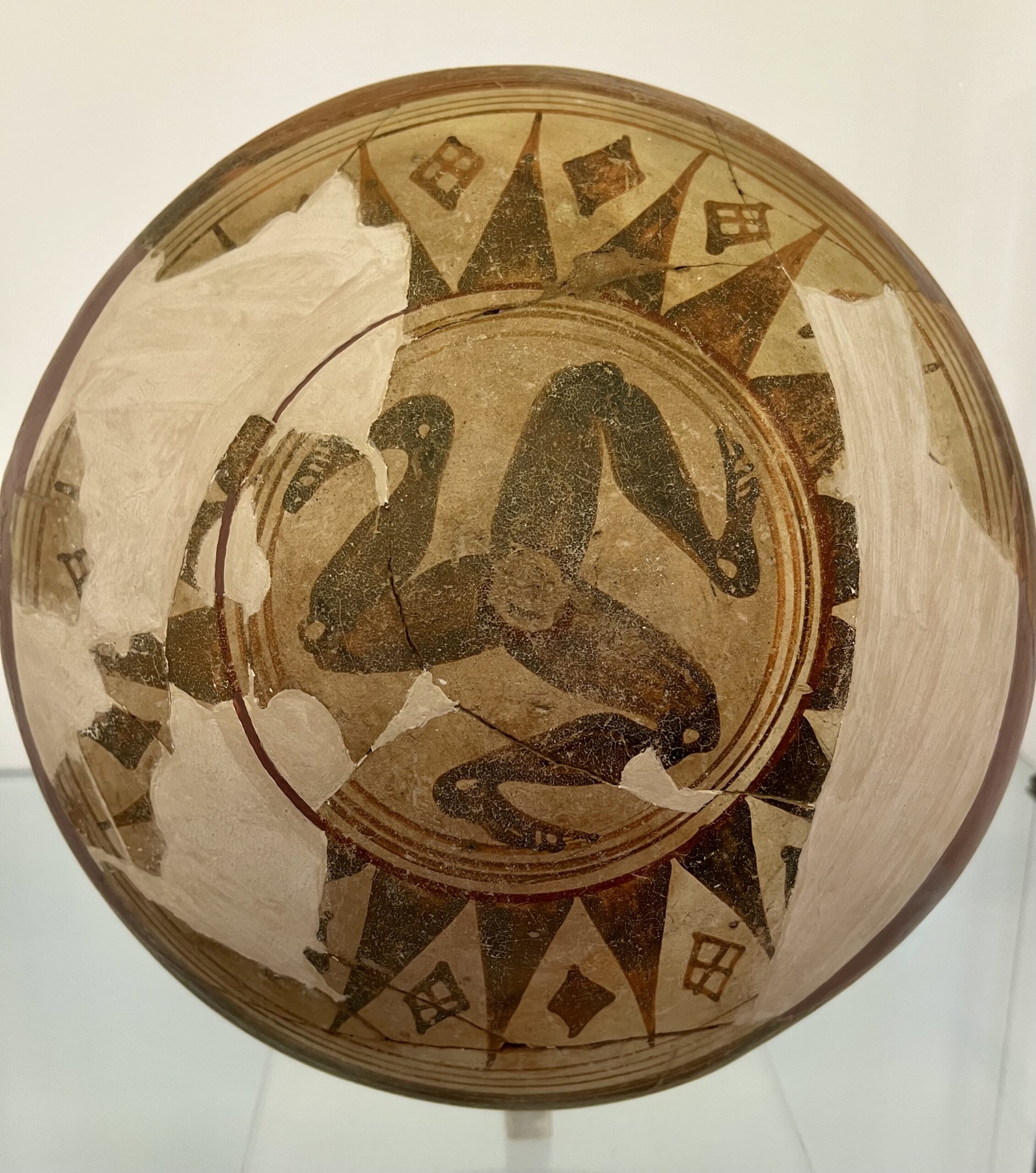
One must see is the Triskeles Bowl. It’s the first known representation of the three legged symbol of Sicily, the Trinacria. Another is a white krater depicting Perseus and Andromeda. It’s an extremely rare krater bowl made from white clay used to make porcelain today.
On the lower level, in the main hall, you’ll see the museum’s centerpiece — the awe-inspiring reconstructed Telamon, or stone giant, from the Temple of Olympian Zeus.
The telamon represented Atlas, the son of Jupiter and Asia. He was condemned to support the world on his shoulders as a punishment for helping the Titan.
The telamon was discovered and rebuilt by R. Politi in 1825. It’s displayed upright in a huge hall, quite spectacularly.
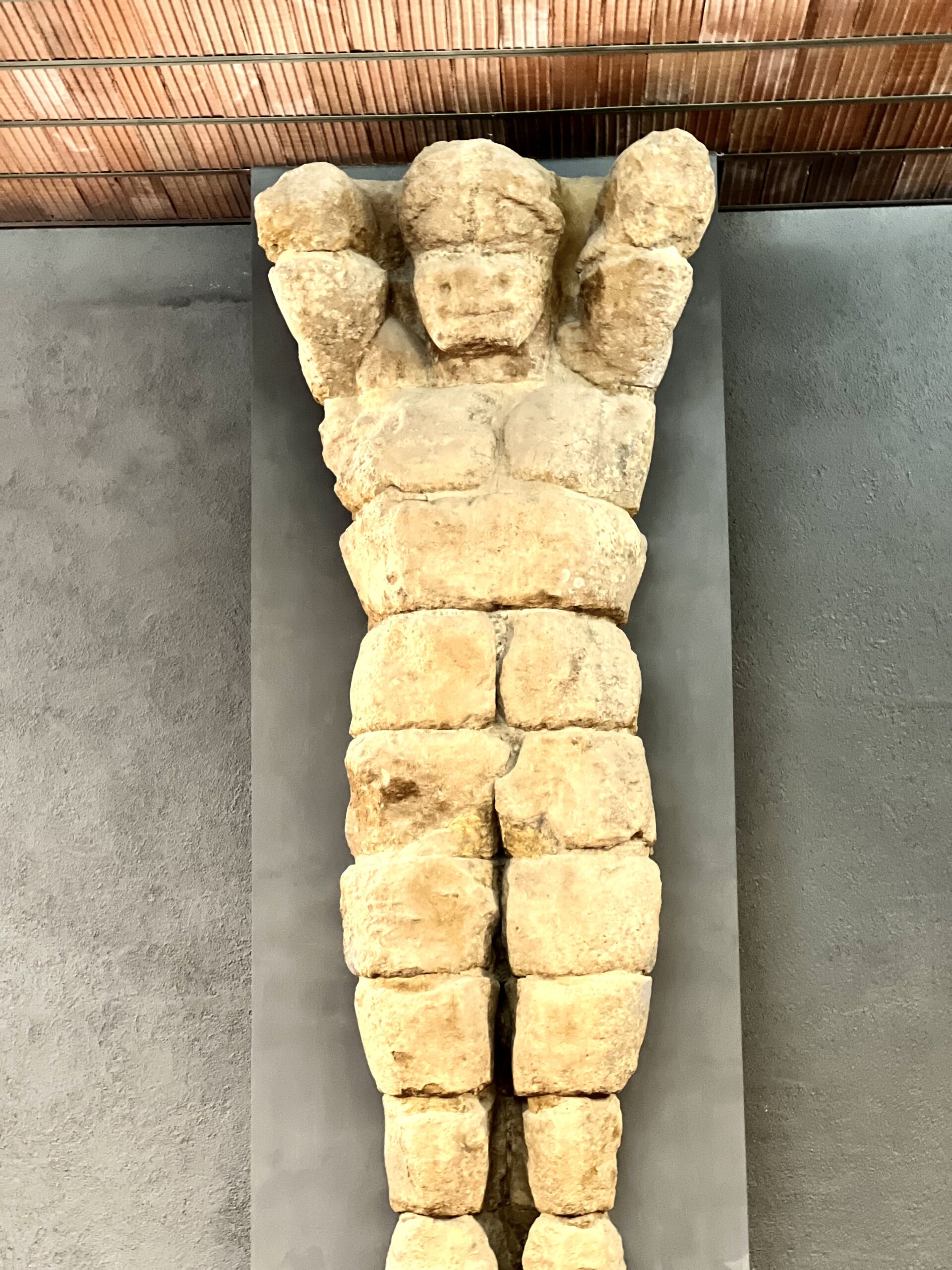
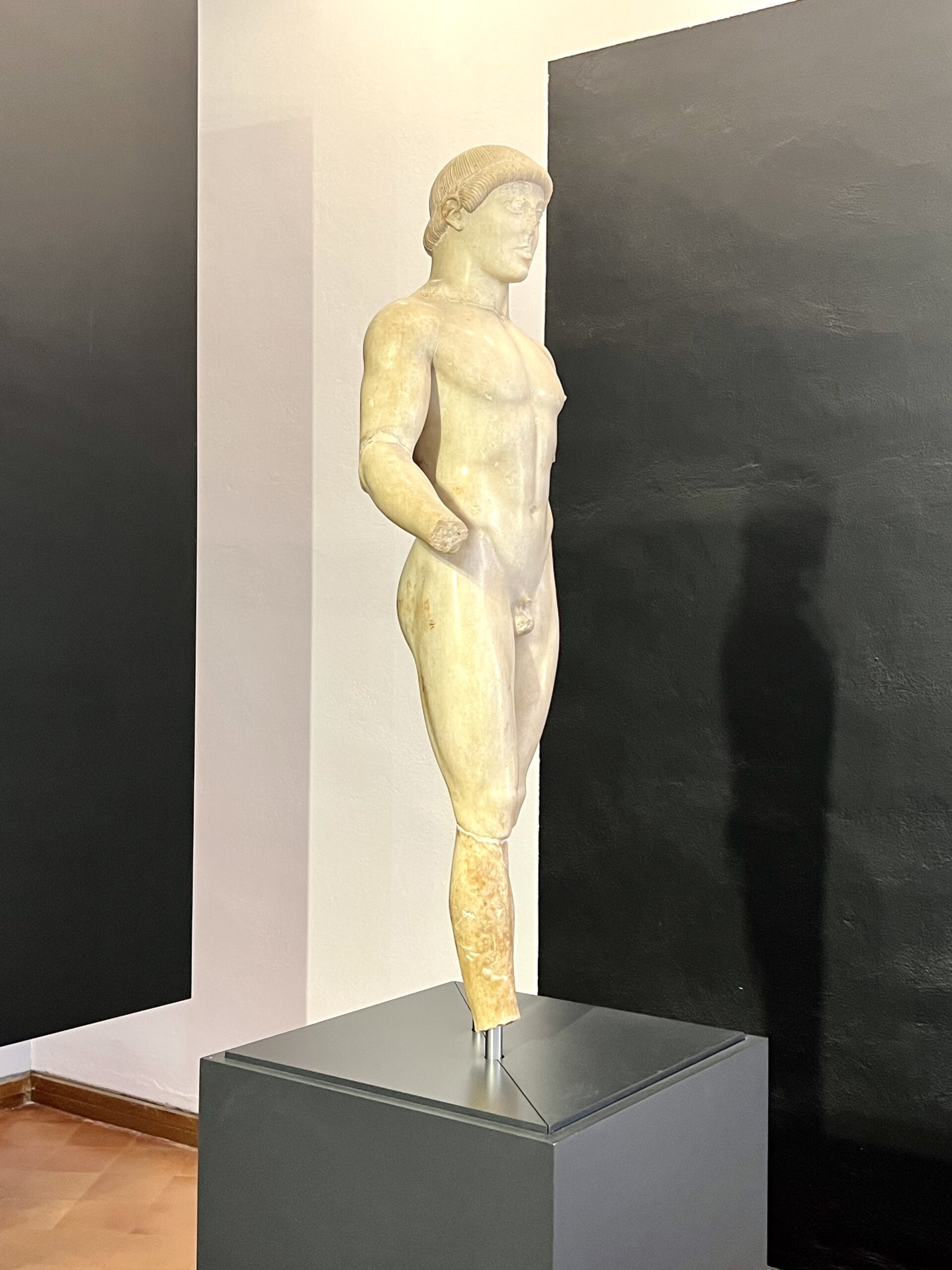
There’s also a model of the temple where the telamon once stood. The telamon was just one of 38 sculptures that decorated the sides of the temple. To the left, you’ll see three large heads from other telamon.
Another museum highlight is the Kourus, a Greek sculpture of a young boy. It was once on display at the Getty Villa in Los Angeles and was returned with an earthquake proof podium.
There’s a section with three Roman busts. You can see that Hadrian’s bust doesn’t really match the body it’s set on.
The Romans were practical and swapped heads instead of making new sculptures from scratch, a method my guide called “ancient photoshopping.”
The viewing terrace outside serves up panoramic views across the valley to the temples themselves — wonderful.
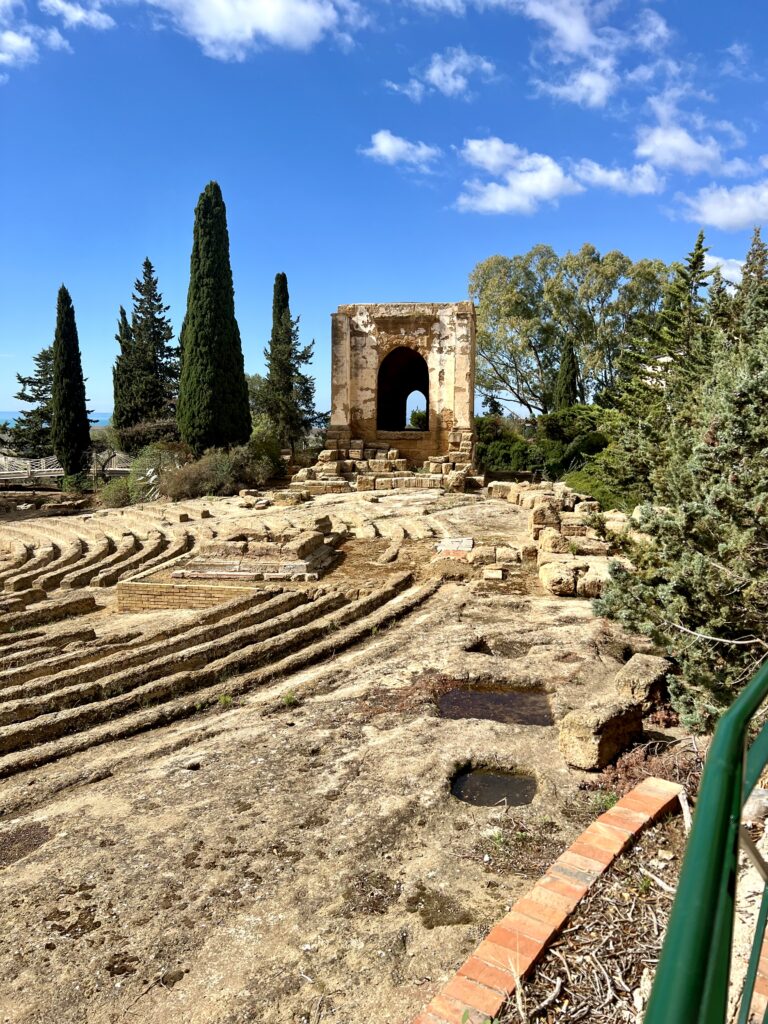
2. Ekklesiasterion and Oratory of Phalaris
The first thing you’ll see on a visit is the Ekklesiasterion, which looks like a miniaturized amphitheater.
Built in the 4th century B.C., it was a pubic space where citizens met to discuss affairs of state every nine days. The space seated up to 3,000 people on 22 horizontal rows of seats. Every session was opened with a sacrifice of a calf or pig to Zeus.
Connected to the theater is the so-called Oratory of Phalaris, dating from the 1st century B.C. It’s a small religious monument dedicated to a tyrant. The cella, or inner chamber, is all that survives.
Phalaris was famous for commissioning a bronze bull from the Athenian sculptor Perillo. He would place his enemies inside the bull and roast them alive. The shrieks from inside mimicked the roars of a bull. Not surprisingly, in 554 B.C., Phalaris was stoned to death by the inhabitants.
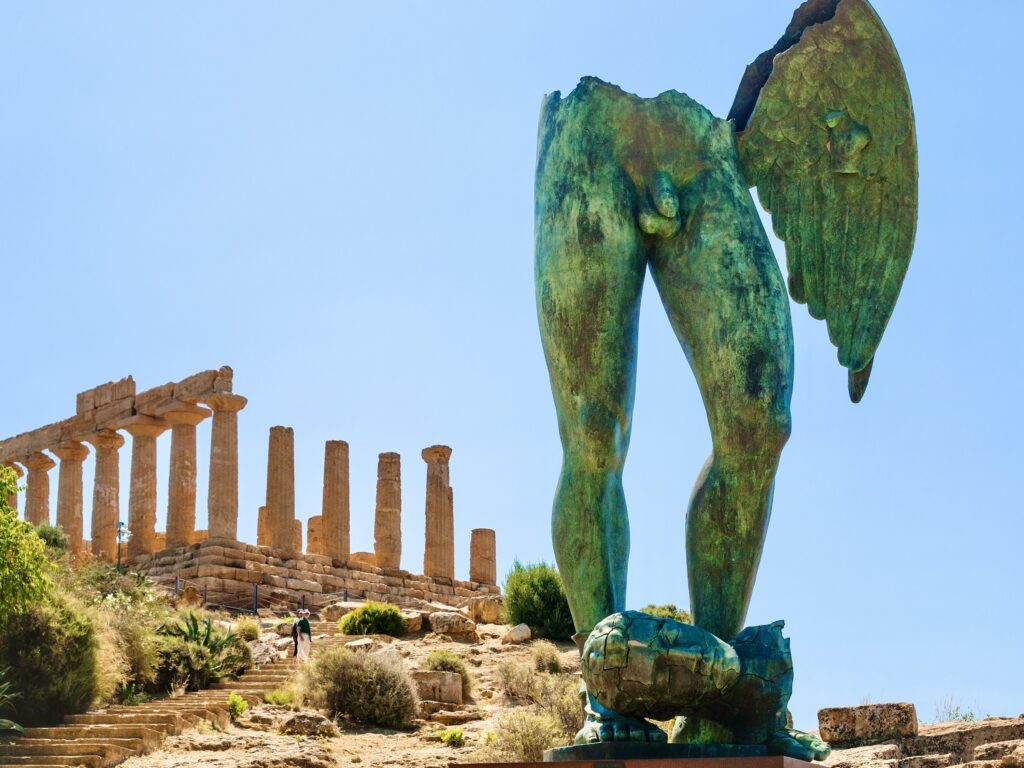
3. Temple Of Juno
Built in 450-40 B.C., the Temple of Juno (or Hera) was erected on the eastern end of the hill of temples. It was a Doric style temple with 6 columns across the front and back and 13 on the sides.
Though it’s named for Juno, it’s just a guess which god was worshipped here.
It’s believed that the temple was a sanctuary for both newlywed couples and for married women whose husbands had been unfaithful.
The temple was 135 feet long. The interior was divided into 3 rooms: the porch, the central cella, and a room at the rear called an opisthodomus. On the side walls of the cella were stairs leading to the roof.
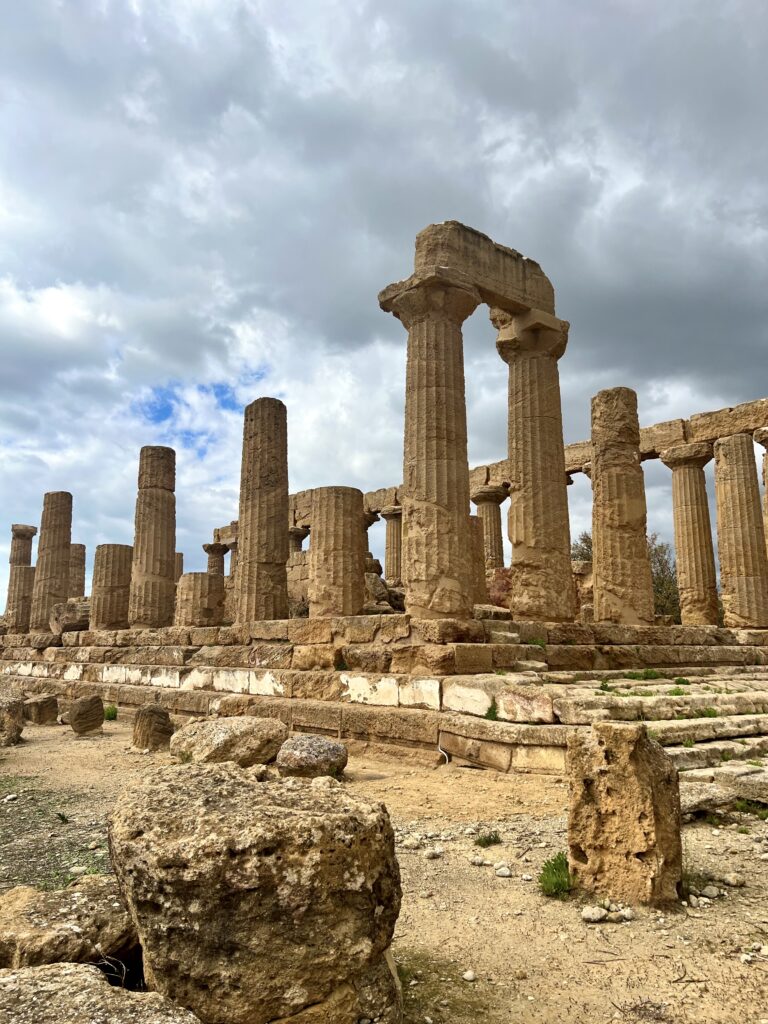
At the center of the cella was a raised altar used for sacrifices to the god and a statue of Juno on a four step pedestal.
The temple stood until 1500, then crumbled from the impact of an earthquake. In the late 18th century, a local aristocrat reassembled the temple.
30 columns are standing and 16 have there original capitals.
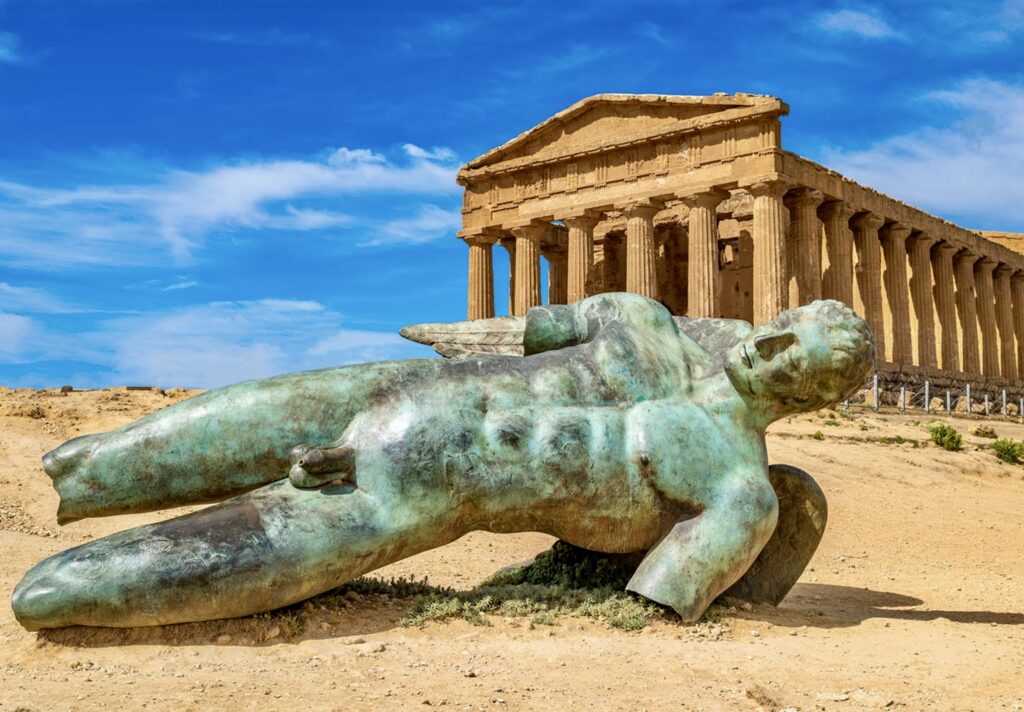
4. Temple of Concordia
Erected in 430 B.C., the Temple of Concordia is the world’s best preserved Doric style Greek temple. Ironically, when built, it was the least important temple in the Valley of Temples. Like all other Greek temples, it faces east.
Concordia is the only temple in Sicily that never collapsed. The temple was dedicated to an unknown deity. Its name comes from a (probably unrelated) inscription discovered nearby by historian Tommaso Fazello.
One explanation for the temple’s longevity is that it was converted into a Christian church during Byzantine times and remained that way for 2,000 years until 1788. Inside, you can see three naves, characteristic of a church.
The temple has a double dedication. Originally, it was likely dedicated to Castor and Pollux. As a church, it was dedicated to Saints Peter and Paul.
The temple was once a dazzling blue and red with polychrome decorations, though there were no decorative relief sculptures on the pediment.
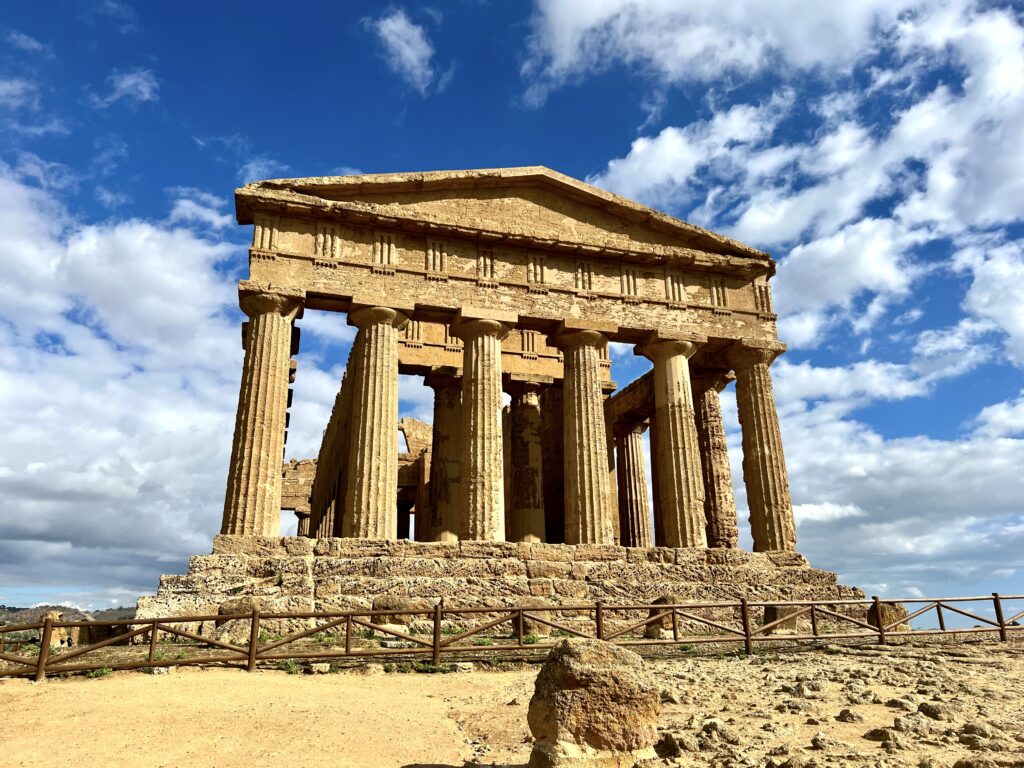
Like the Temple of Juno, Concordia once had 6 columns in the front and back and 13 on the sides. The interior was divided into 3 rooms.
Concordia is a perfectly-built temple, the epitome of Hellenistic genius. It was constructed with perfect ratios, tapering columns, sublime harmony, and optical refinements.
One such refinement was that the columns have a slight bulge and lean inward slightly. That innovation make them look straight from afar.
The builders also solved the unsightly “corner problem” most temples had at the time as a result of being built with stone instead of wood. To fix this, architects alternated triglyphs and metopes and centered the triglyphs above the column below.
A contemporary statue of Icarus, by Polish artist Igor Mitoraj, lays to the right side of the temple. It was part of a 2011 exhibition and is the only remnant left in place.
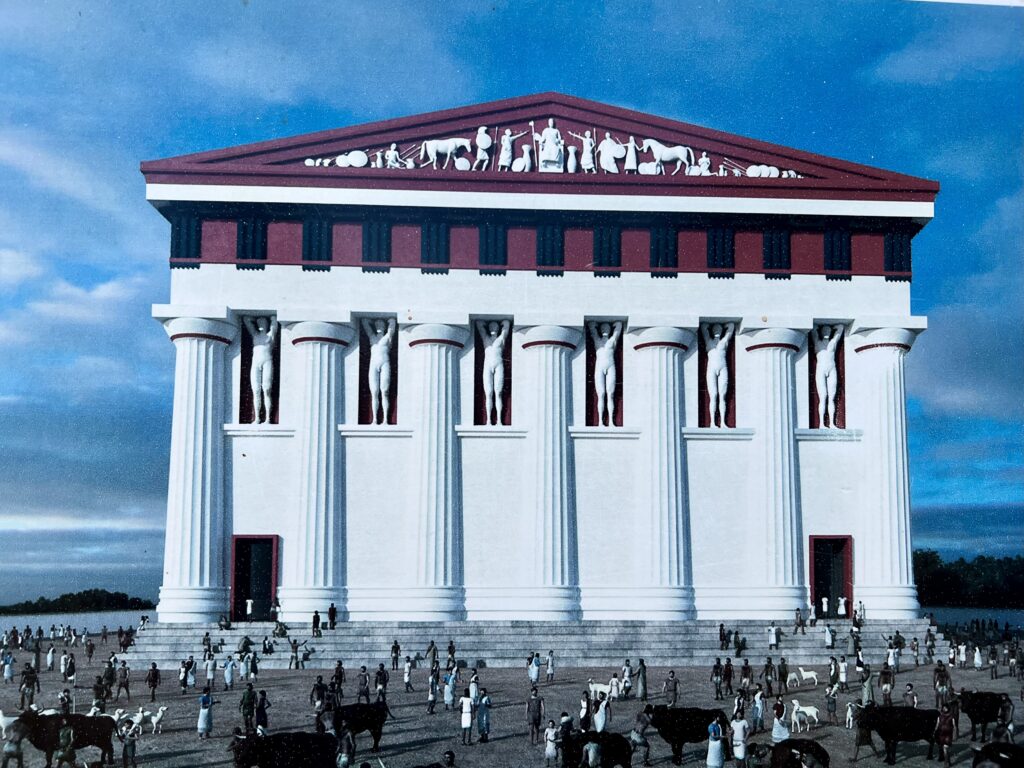
5. Temple Of Olympian Zeus
The Temple of Olympian Zeus was once one of the world’s largest Greek temples. Dedicated to Zeus, it was the most important one in the valley. The temple is now in ruins, so it’s hard to get a sense of its once majestic presence.
The temple was built after a Greek victory over the Carthaginians in 480 BC. It’s Doric in style, but is known as a heptastyle temple. There are 7 columns along the front and 14 on the sides. It was 107 feet high.
Unlike most temples, the Temple of Zeus had a series of half columns and a solid outer curtain wall, instead of the more typical free standing columns. 38 foot tall statues of giant telamons stood on recessed ledges within the column niches.
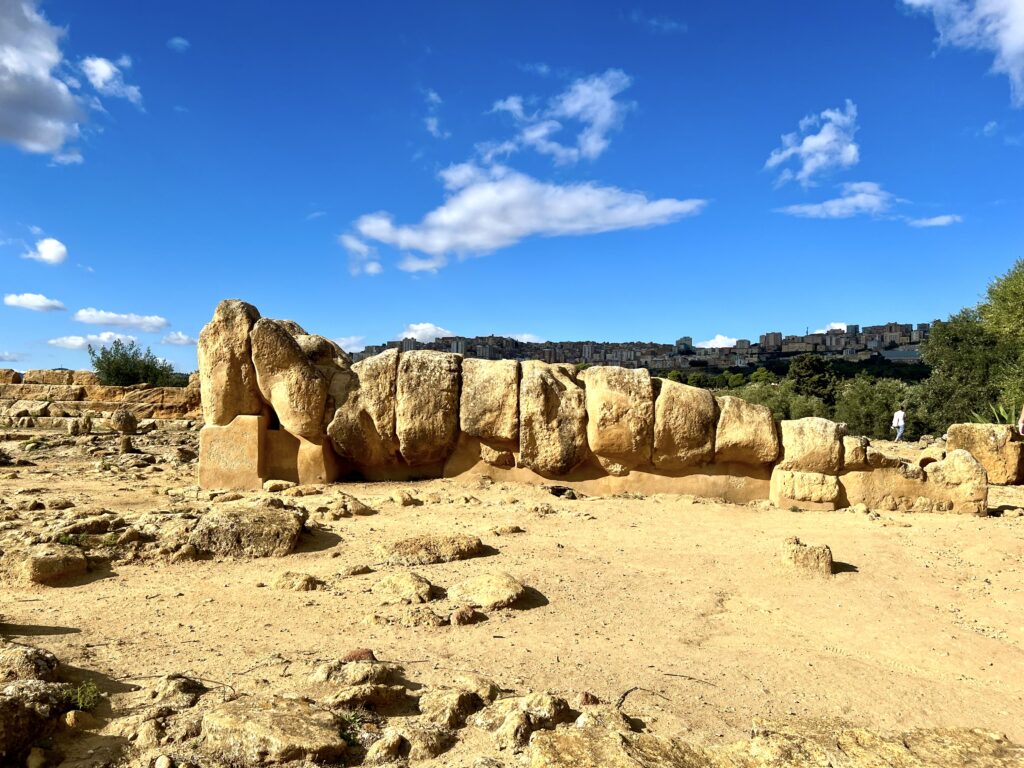
Today, only 5% of the temple’s original stones remain. It collapsed in 1401 and was recycled into other buildings.
You can still see three telamon giants (like the one in the museum) being assembled onsite. The goal is to create a steel frame to enclose them for viewing.
Discoveries suggest that, on the front of the temple, female caryatids may have stood in place of columns holding up the entablature. The relief work on the east pediment depicted a traditional battle scene among gods and giants. The west pediment showed stories from the Trojan War.
The temple was never fully finished. The historian Fazello claims that the last columns standing fell in 1401.
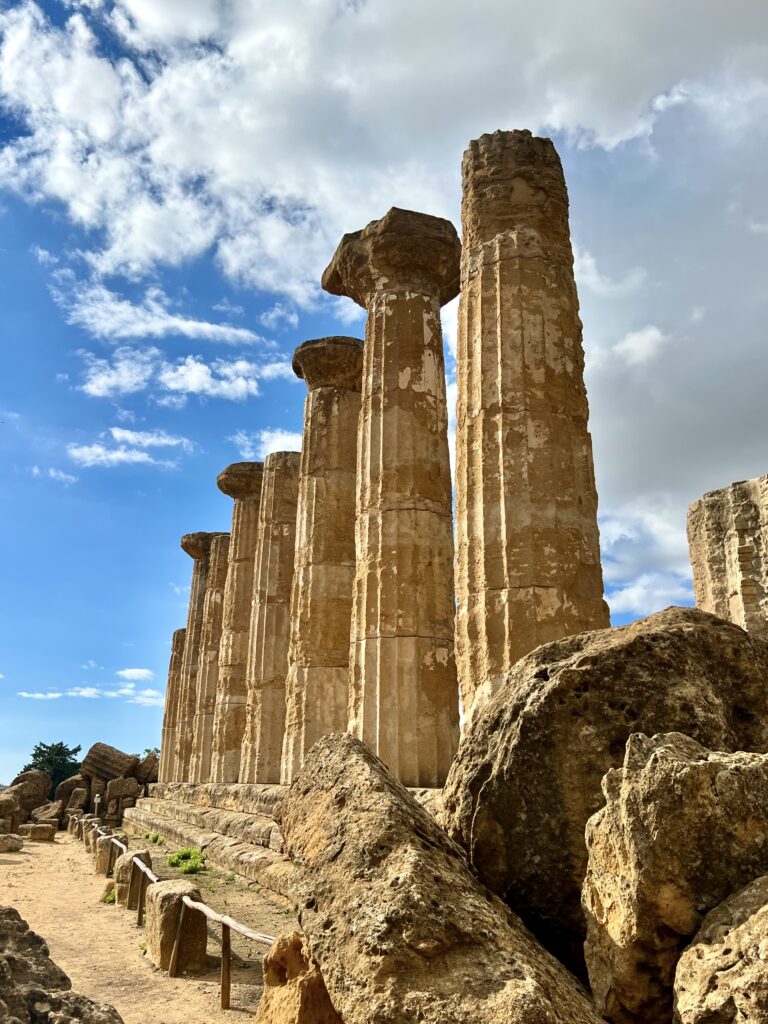
6. Temple of Hercules
The Temple of Hercules is the oldest structure in the valley, dating back to the late 6th century B.C. It received its attribution based on testimony by Cicero.
Once one of the most beautiful temples of antiquity, it’s now reduced to a few standing and partially ruined columns. Even so, the temple is imposing and evocative.
The temple was dedicated to Hercules, the national hero of Sicily. The locals would invoke Hercules against nightmares and deceptive dreams.
Among other things, Hercules was famous for freeing the world from the Nemean lion, killing the Lernaean hydra, taming the wild bull of Crete, and rescuing Theseus from Hades’ underworld.
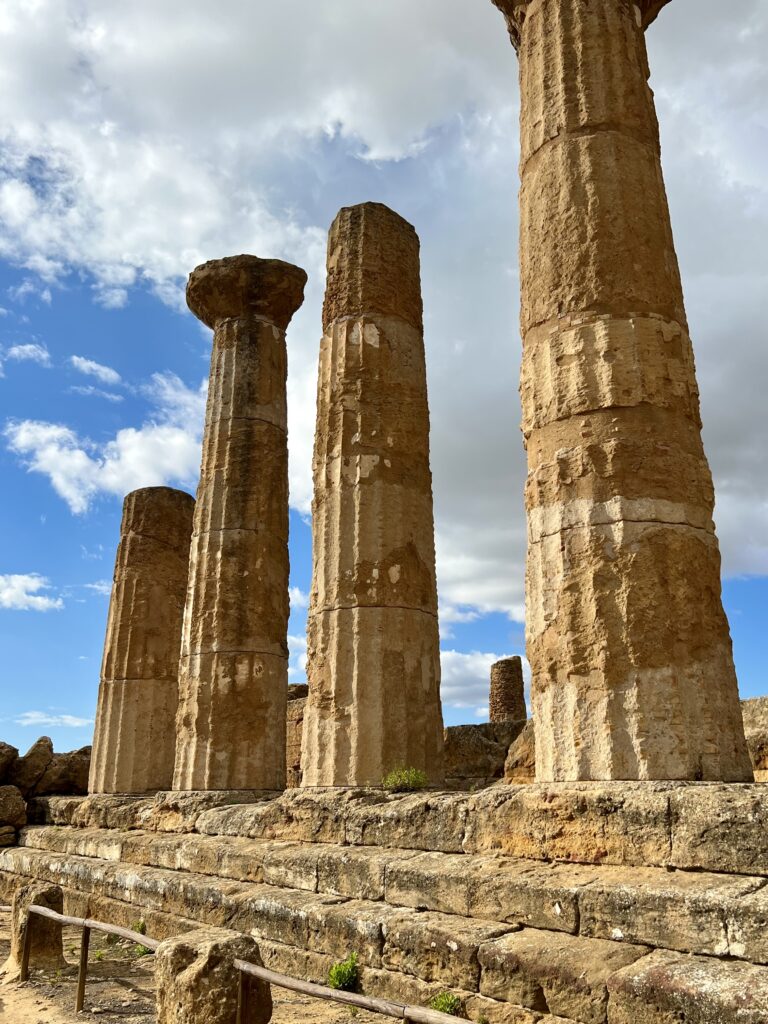
Only 9 columns of the temple are left today. Englishman Alexander Hardcastle was responsible for reconstructing them.
In its heyday, the temple was decorated in red, pale blue, and deep blue. The pediment was decorated with sculptural friezes.
A marble sculpture of Hercules once stood inside. The torso was recovered and is in the cloisters of the Archaeological Museum. According to Cicero, the sculpture was so beautiful that part of its face was worn from the kisses of devotees.
You can walk around the temple and see the scattered ruins and some capitals. In places, you can see traces of white plaster.
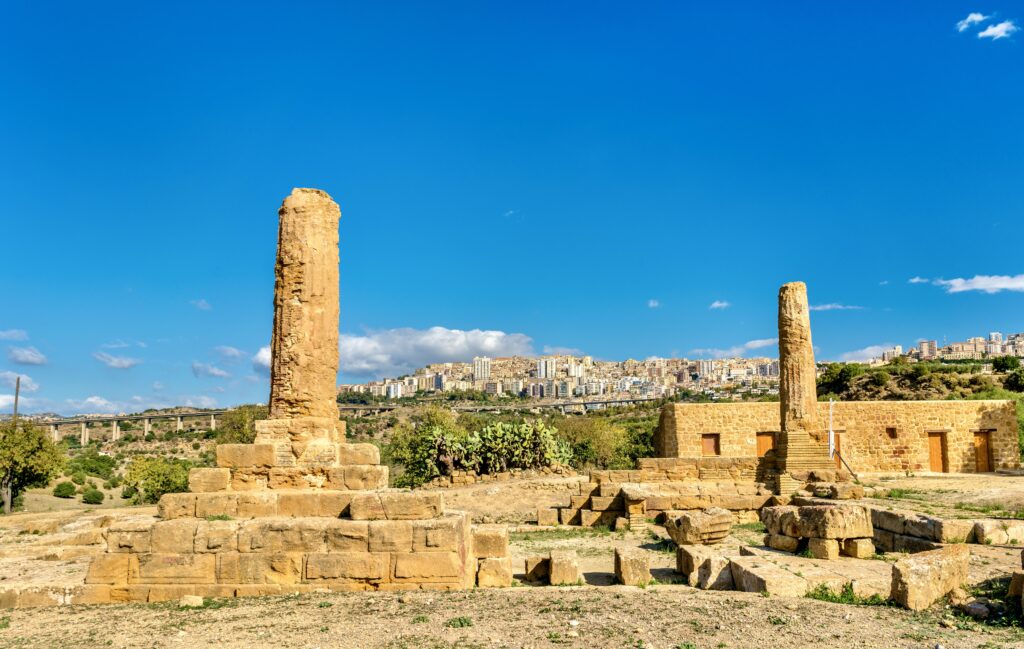
7. Temple of Hephaestus (Vulcan)
Today, the Temple of Vulcan consists of only 2 columns and a ruined base. It was built around 430 B.C. and, like all the temples, faced east.
However, the footprint of the temple, built on the foundations of an even older one, suggests it was once one of the most important in the valley.
Hephaestus, known as Vulcan in Roman mythology, was the god of industry and work. Frightful to look at, he nonetheless married Venus.
According to legend, Hephaestus had his workshop at the base of Mount Etna, where he made thunderbolts for Zeus with the help of the cyclops.
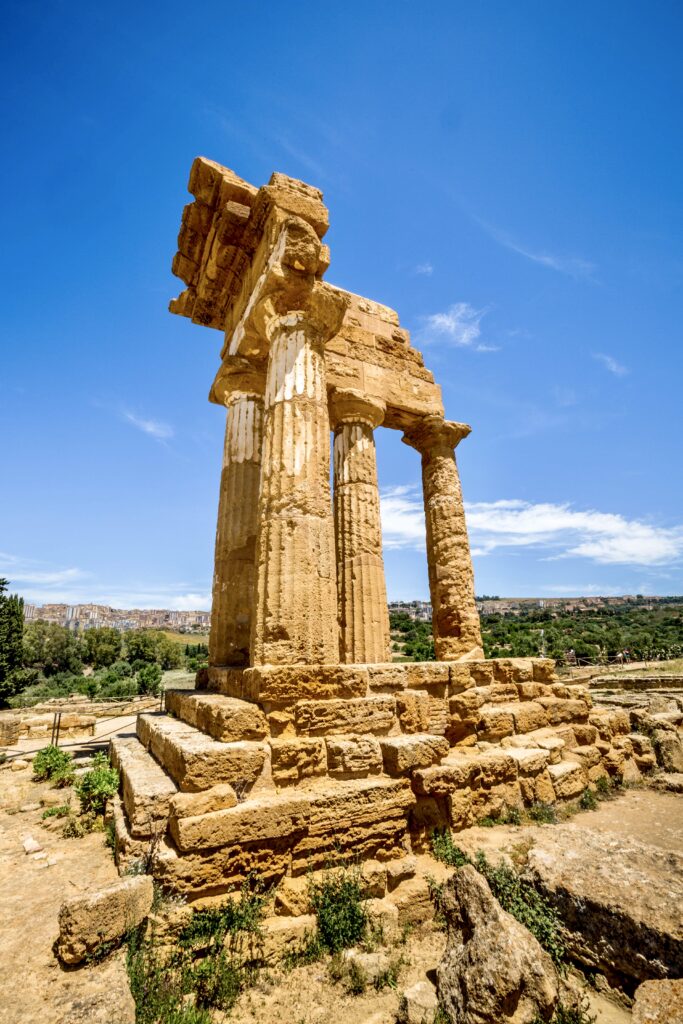
8. Temple of Castor and Pollux
The final temple you’ll see on your walk through the park is the Temple of Castor and Pollux. The original was completely destroyed. What you see in its place is not the real deal.
The temple is a whimsical folly created in the early 19th century to impress travelers on the “grand tour” of Europe. It looks like something out of the Roman Forum, but it’s an inaccurate historical representation.
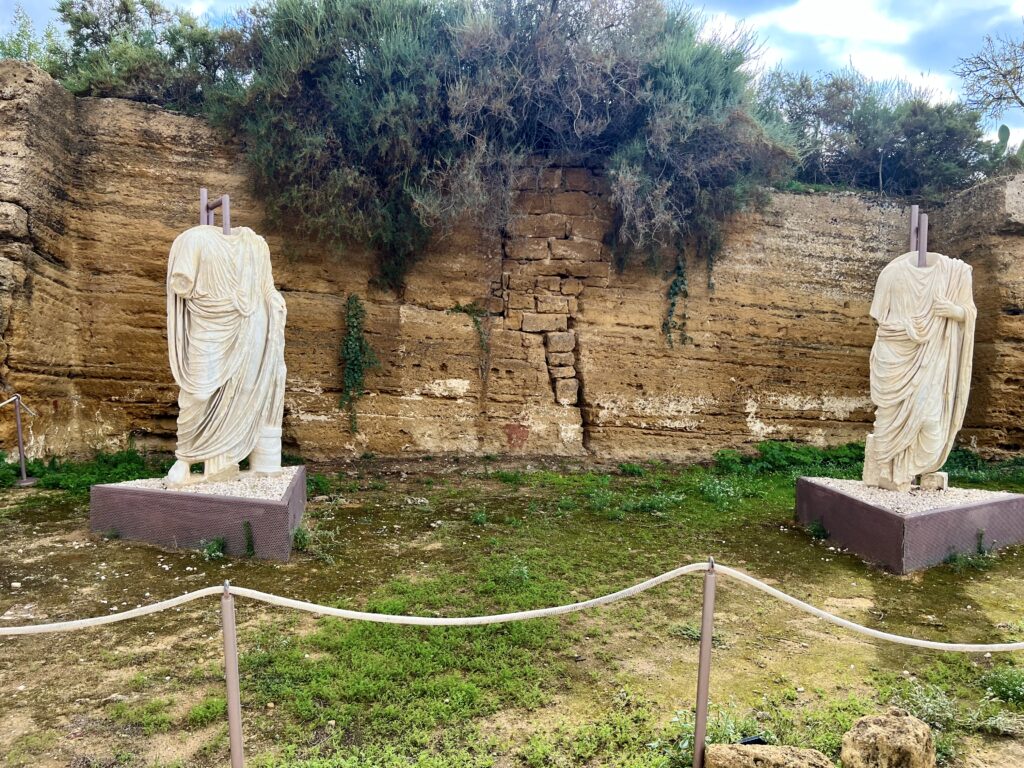
9. City Walls and Burial Holes
Dating from 500 B.C., the city walls of ancient Akragas were cut out from the natural outcrop. There were once 7 miles of walls, 9 gates, and some secret passages. Frescos once adorned the arches.
Over time, part of the walls were turned into an early Christian necropolis. Tombs were built into the natural cavities of the walls. Called arcosolia, they look like burial holes.
They were constructed between the 4th and 7th centuries B.C. Today, they are effectively windows to the sea.
The Carthaginians and other invaders destroyed the walls. A series of earthquakes further devastated the entire valley.
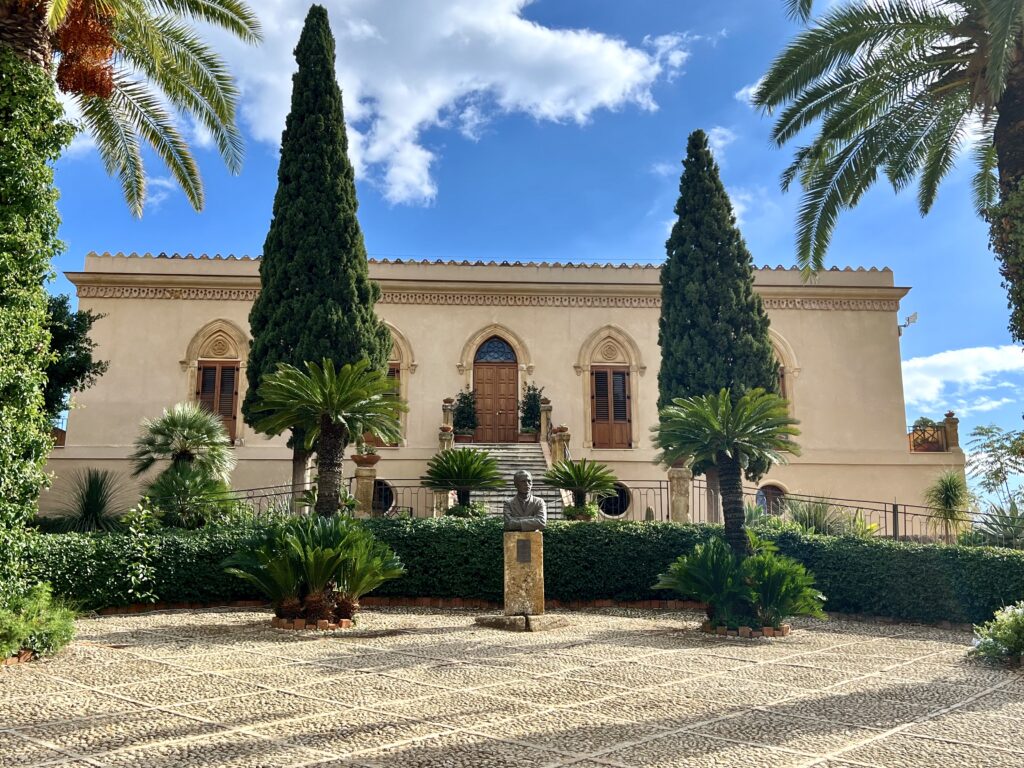
10. Hardcastle Villa
Villa Aurea was the home of the late English captain and patron of the arts Alexander Hardcastle. He developed a passion for architecture after visiting the temples in 1921.
Hardcastle moved to the site and spent his considerable personal fortune reconstructing the temples. Thanks to his efforts, the Temple of Hercules was re-erected and many ancient monuments were discovered.
Hardcastle became a local personality. Upon his death, he was buried in a tomb in the Bonamorone cemetery of Agrigento.
Today, the villa hosts art exhibitions. If it’s open, you can head in and admire the gardens.
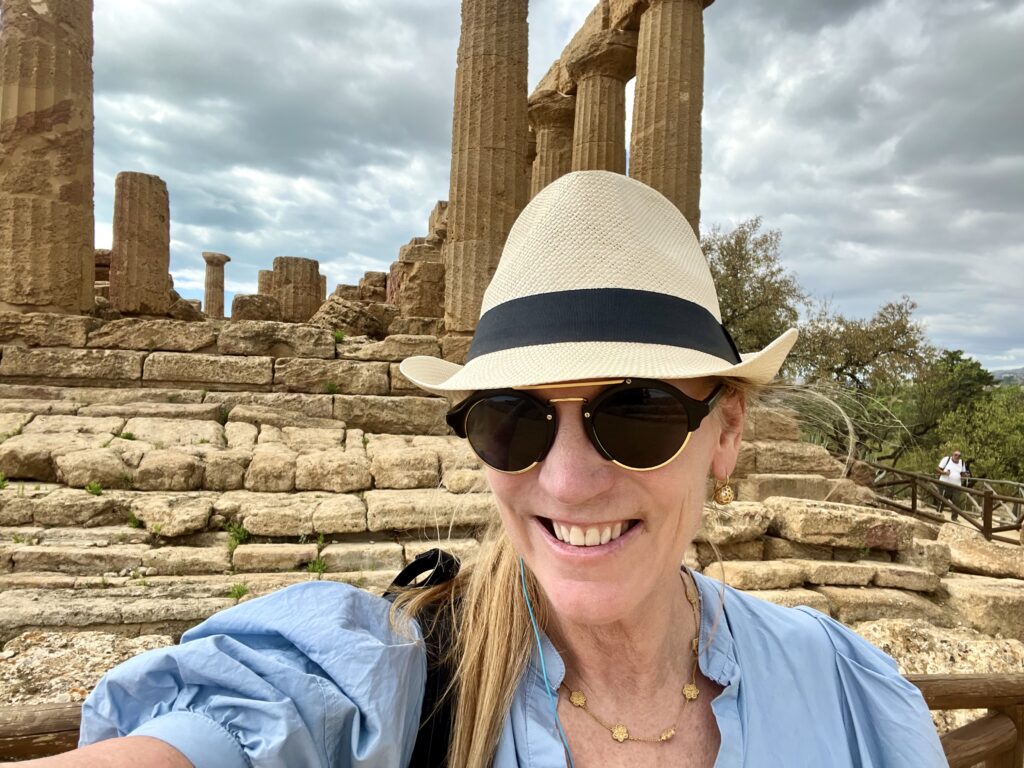
Practical Guide & Tips The Valley Of The Temples In Agrigento
No guide to the Valley of the Temples would be complete without some must know tips for visiting.
1. How To Get To The Valley Of The Temples
By Car:
The Valley of the Temples is near the southwestern coast of Sicily. It’s 80 miles by car from Palermo, 108 miles from Trapani, and 100 miles from Catania.
It’s reachable by car via regional highways connecting to Agrigento. There are parking lots next to both entrances that look like dirt fields. It costs 2 euros to park.
By Train:
Trains run from both Palermo and Catania. Palermo Centrale station has several trains a day and the journey takes 2 hours. From Catania Centrale, it’s a minimum 5 hours with at least two train changes.
From the station in central Agrigento, it’s a 2 mile walk to the park entrance. You can also take the #2 bus and disembark at the Temple of Juno (eastern) entrance.
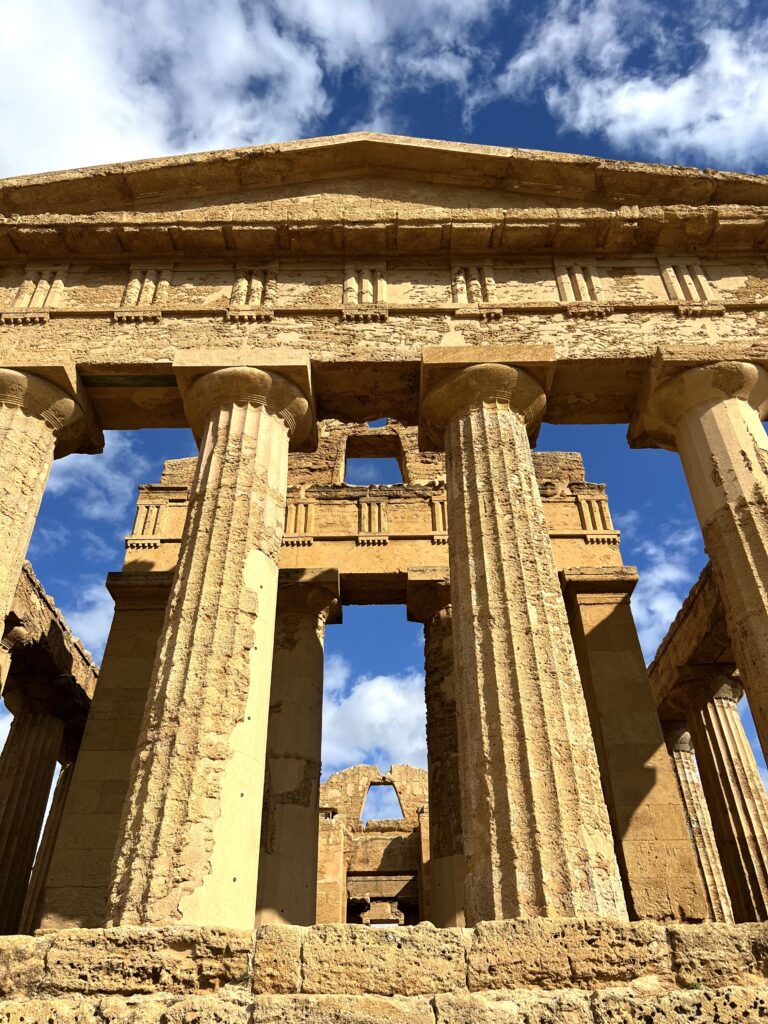
2. How To Get Around The Valley Of The Temples
There are two entrances to the Valley of the Temples. The eastern entrance is outside the Temple of Juno. (That’s the entrance I used.) The western entrance is Porta Quinta.
The park is split into two zones, east and west. Your ticket covers both zones and you can visit them in either order.
If you are coming from the museum, you’ll start in the eastern zone. It’s about a 15-20 minute walk or 5 minutes by car or bus.
In this zone, you’ll find the “superstar” ruins — the Temple of Juno, the Temple of Hercules, and the Temple of Concordia. There’s also a cafe and free public rest rooms.
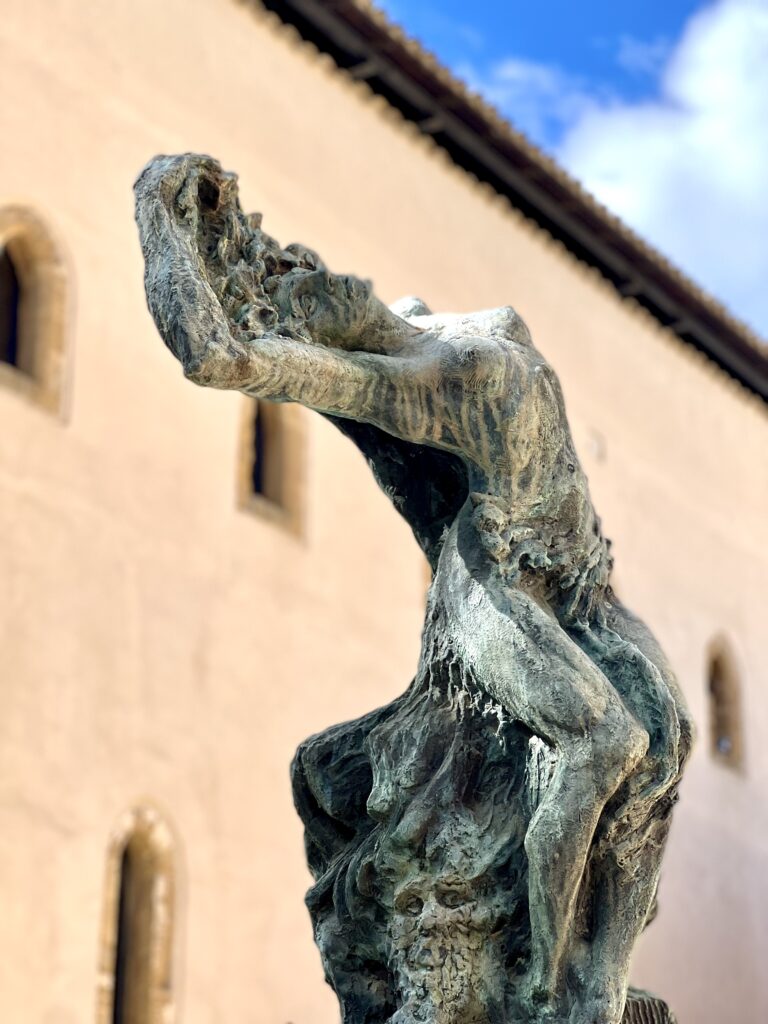
In the western zone, you’ll find the Temple of Zeus, the Temple of Castor and Pollux, and a Sanctuary dedicated to the goddesses Demeter and Persephone. There are also some indigenous goats.
To get around the valley, it’s easiest to just walk. But there is quite a bit of walking involved.
A main path, the Strada Panoramica, takes you across the valley. But you’ll have to walk over uneven ground to get a closer look at the temples.
To explore all the sights in the park, you will need to walk approximately 3 miles. For 3 euros, an electric shuttle bus takes you from one entrance of the park to the other and makes 4 stops. You can also take a guided electric scooter tour to zip around quickly.
On a visit, you should budget 3 hours to see everything.
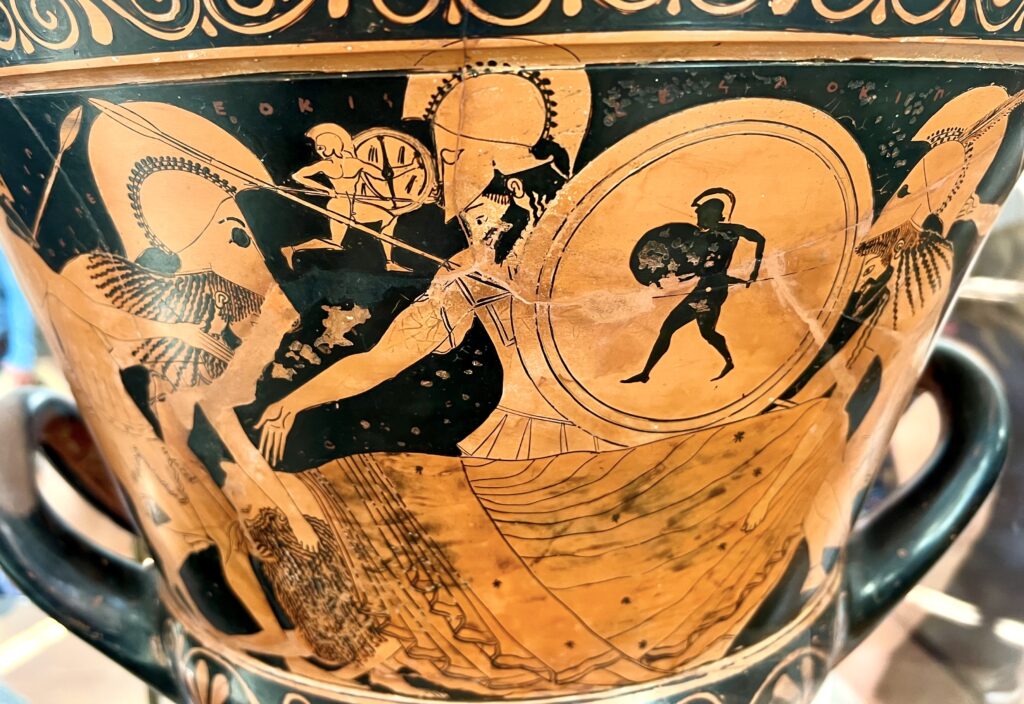
3. Tickets For The Valley Of The Temples
Tickets can be purchased at either the western or eastern entrance with cash or card. You can also pick up a map from the ticket office.
Ticket prices for the Archaeological Museum are:
- Price € 8 per person
- Concession € 4 per person
- Audio guides are € 5
You’ll definitely want to pick up an audio guide if you’re not on a tour. You’ll need to leave an ID as a “deposit.”
Ticket prices for the Valley of the Temples are:
- Price: € 10 per person
- Concession: € 5 per person
- Free admission: the first Sunday of the month until 7:00 pm
A combined ticket for both attractions is:
- Price: € 13.50 per person
- Concession: € 7 per person
You can also book a skip the line ticket online in advance, which is advisable in high season.
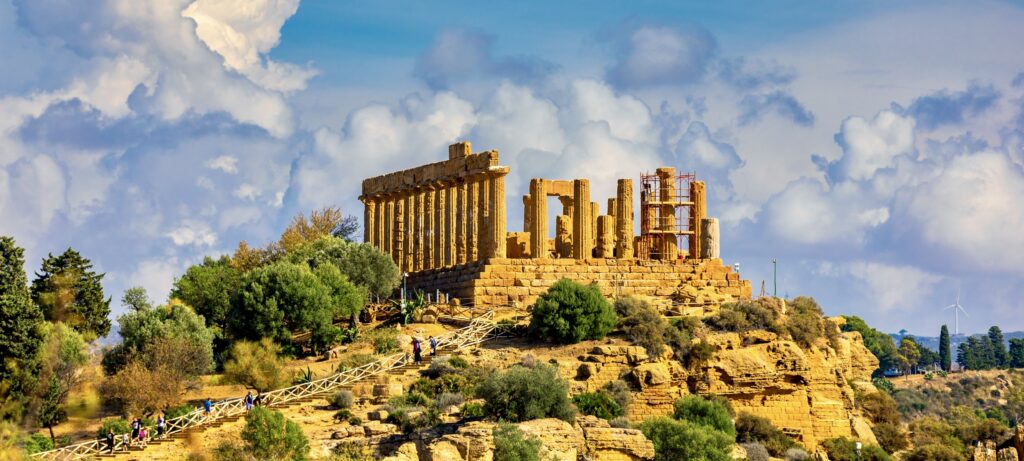
4. Opening Hours
The park is open every day from 8:30 am to 7:00 pm. During high season in the summer, the hours extend to 11:00 pm on week days and until midnight on Saturdays and Sundays.
Prepare for the heat. Sicily is hot and there is no shade in the park (except perhaps under an olive tree). You should plan to wear a hat and bring water. There are vendors at the entrance selling both.
If you are staying in Agrigento in high season, I suggest you visit in the evening. At night, it cools down and the site is illuminated with lights. The downside is that it might be a bit more difficult to see the uneven surfaces in the park.
You can book a 2 hour evening tour on the valley’s website for 6:30 pm or 8:00 pm.
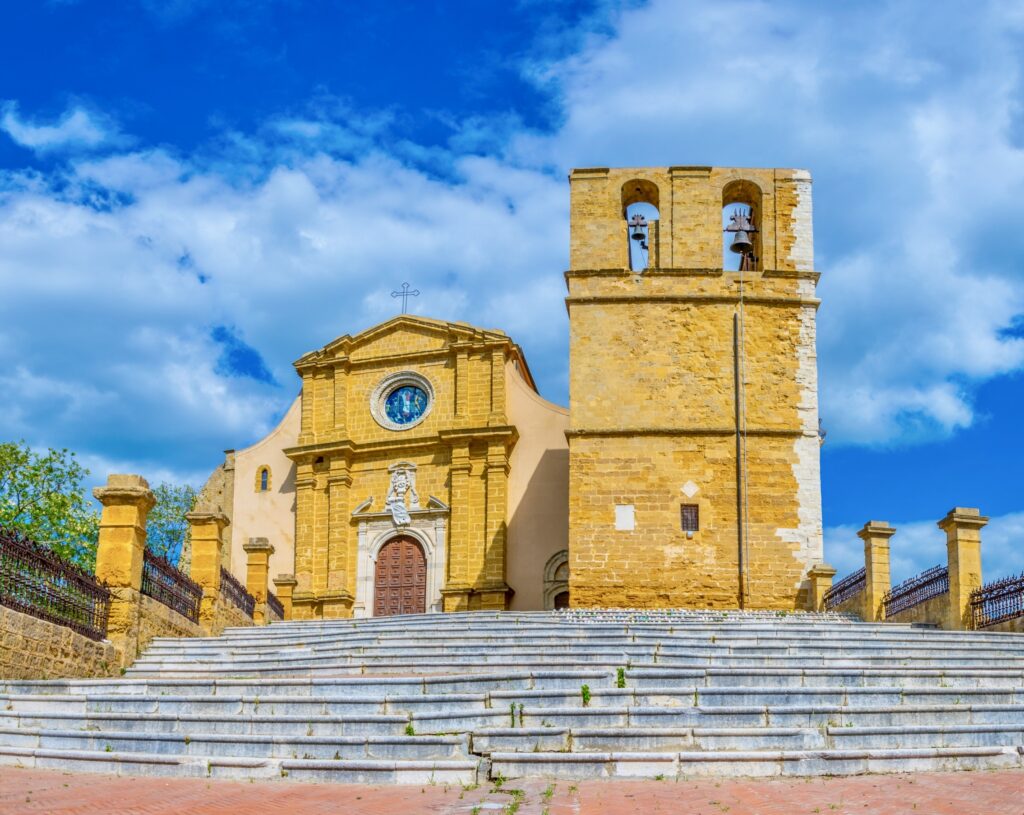
5. The Town of Agrigento
While you’re at the archaeological site, why not visit the historic center of Agrigento itself? Agrigento itself is nothing special, but it has a lovely medieval core.
The main drag is is Via Atenea, which is lined with boutiques, eateries, and bars. You’ll get some hiking in too. Narrow alleyways wind upwards off the main street, past tightly packed palazzi and historic churches.
You can check out the cathedral. Or, you can hit the beach and relax after visiting the temples. The most spectacular beaches are Scala dei Turchi and Eraclea Minoa.
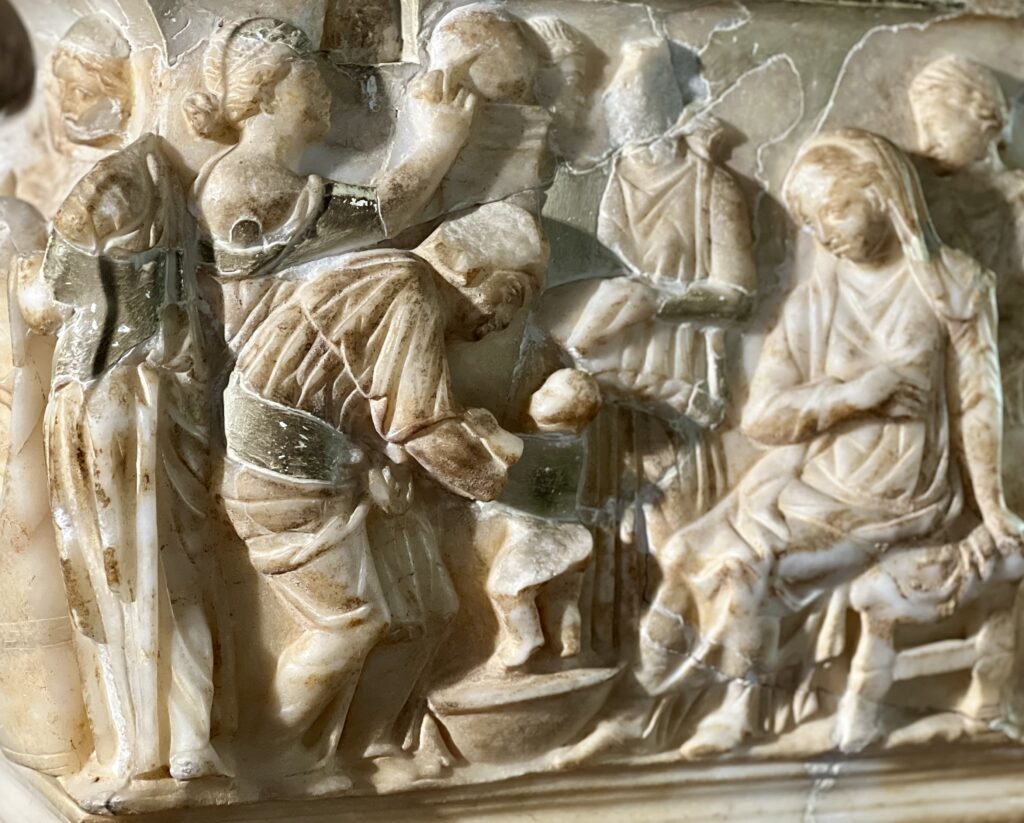
6. Where To Stay In Agrigento
If you have sore soles from trekking around the valley, there are plenty of good places to overnight in Agrigento. From many of them, you’ll have great views of the valley, which is illuminated at night.
Hotel Villa Athena is definitely the best place to stay. It’s a luxurious hotel with a prime location just a few steps from the temples. You’ll find 28 marbled rooms with terrific views in a serene setting.
If you’d like an agriturismo retreat, check out Casa Balata. It’s a countryside retreat about a 20 minute drive from the temples. You can relax and enjoy a pool, manicured gardens, and great meals.
Hotel Della Valle and the Doric Boutique Hotel are also good options.
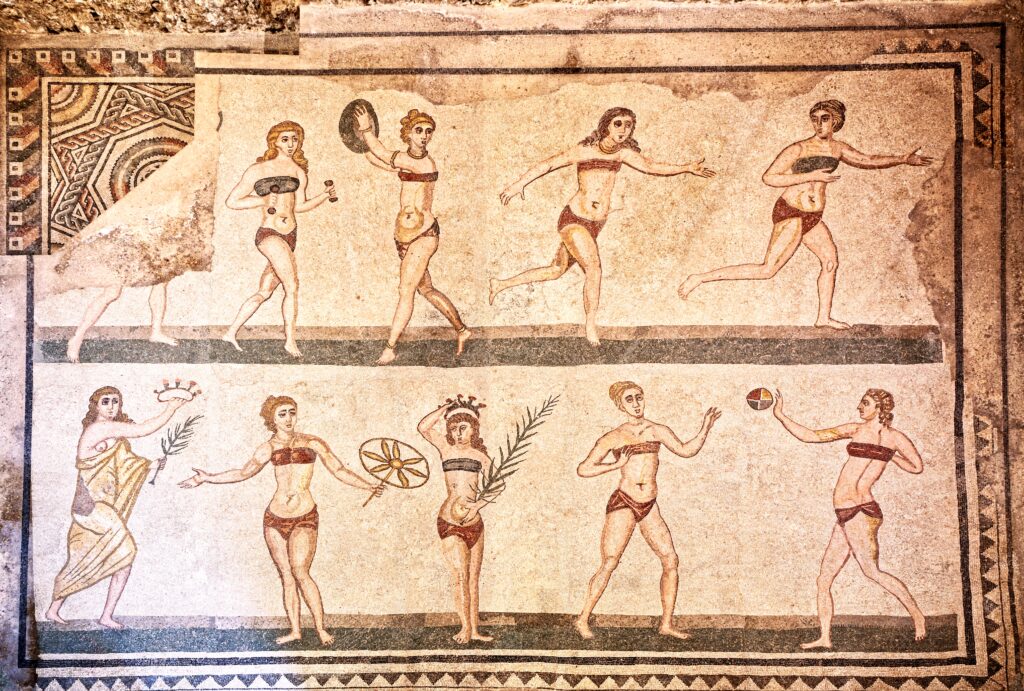
7. Attractions Near The Valley of the Temples
If you are staying in Agrigento, there are two amazing sites to explore that are close to the Valley of the Temples: the Turkish Steps and the Villa Romano del Casale.
The Turkish Steps are a natural wonder and just a short drive from Agrigento. They are a sloping terraced white rock formation that drops into the ocean. The steps resemble a staircase (though you can’t walk on them).
Villa Romano del Casale is another UNESCO-listed wonder just an hour from Agrigento. It’s a luxurious 4th century Roman villa with the world’s largest and best preserved collection of mosaics. I promise, the mosaics will blow your mind.
I hope you’ve enjoyed my guide to the Valley of the Temples in Agrigento. You may enjoy these other Italy travel guides and resources:
- 10 Day Itinerary for Italy
- 10 Day Itinerary for Tuscany
- 2 Weeks in Sicily Itinerary
- 1 Week In Umbria Itinerary
- 35+ Historic Landmarks in Italy
- Tips for Visiting Italy
- 5 Day Itinerary for Rome
- 3 Day Itinerary for Rome
- 3 Day Itinerary for Florence
- 2 Day Itinerary for Venice
- 2 Day Itinerary for Palermo
- 1 Day itinerary for Milan
If you need a guide to Agrigento’s Valley of the Temples, pin it for later.

